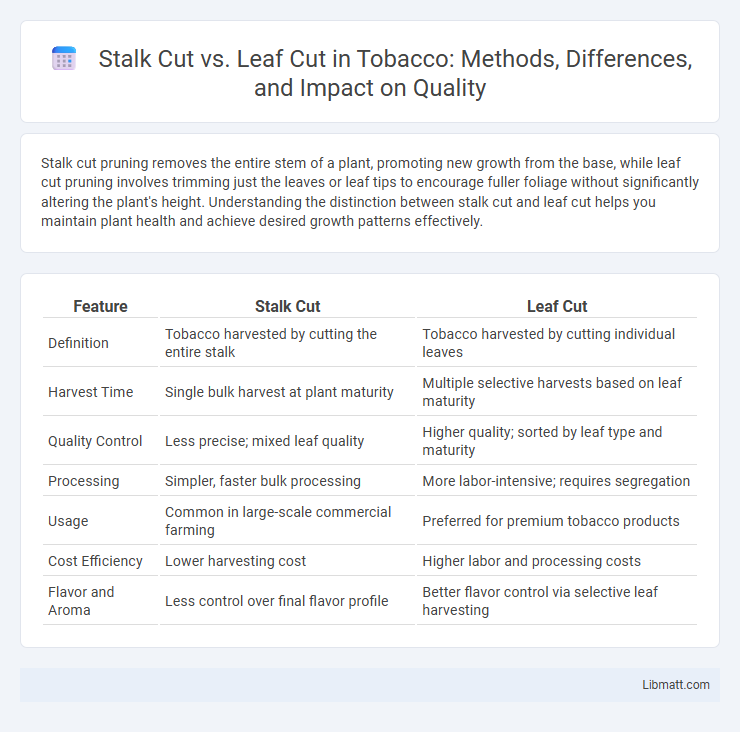Stalk cut pruning removes the entire stem of a plant, promoting new growth from the base, while leaf cut pruning involves trimming just the leaves or leaf tips to encourage fuller foliage without significantly altering the plant's height. Understanding the distinction between stalk cut and leaf cut helps you maintain plant health and achieve desired growth patterns effectively.
Table of Comparison
| Feature | Stalk Cut | Leaf Cut |
|---|---|---|
| Definition | Tobacco harvested by cutting the entire stalk | Tobacco harvested by cutting individual leaves |
| Harvest Time | Single bulk harvest at plant maturity | Multiple selective harvests based on leaf maturity |
| Quality Control | Less precise; mixed leaf quality | Higher quality; sorted by leaf type and maturity |
| Processing | Simpler, faster bulk processing | More labor-intensive; requires segregation |
| Usage | Common in large-scale commercial farming | Preferred for premium tobacco products |
| Cost Efficiency | Lower harvesting cost | Higher labor and processing costs |
| Flavor and Aroma | Less control over final flavor profile | Better flavor control via selective leaf harvesting |
Introduction to Plant Propagation
Stalk cut and leaf cut are common plant propagation techniques used to produce new plants from existing ones by encouraging root development from different plant parts. Stalk cut involves cutting a portion of the stem with nodes, which often results in faster root formation due to the presence of meristematic tissue. Leaf cut propagation allows you to grow plants from a single leaf, making it ideal for certain species that regenerate easily from leaf tissue, offering a cost-effective and efficient method for increasing plant stock.
Understanding Stalk Cuttings
Stalk cuttings involve taking sections of the plant stem, including nodes where roots can develop, making them ideal for propagating many houseplants and herbs. This method often results in faster root formation compared to leaf cuttings, which rely solely on leaf tissue and may take longer or require specific conditions to root successfully. Understanding the differences between stalk and leaf cuttings helps optimize propagation techniques for different plant species.
Understanding Leaf Cuttings
Leaf cuttings involve propagating plants using sections of leaves, promoting root and shoot development from the leaf tissue itself. This method is efficient for species like African violets and begonias, where the leaf contains enough nutrients and meristematic cells to generate a new plant. Unlike stalk cuttings, which require stem sections, leaf cuttings minimize damage to the parent plant while ensuring faster propagation of certain herbaceous plants.
Key Differences: Stalk Cut vs Leaf Cut
Stalk cut involves harvesting the entire stalk of a plant, preserving the main stem and associated leaves, whereas leaf cut focuses solely on removing the leaves while leaving the stalk intact. Stalk cutting is commonly used in crops like sugarcane and corn to maximize biomass and structural yield, while leaf cutting is prevalent in tea and tobacco production to enhance quality and flavor. The choice between stalk cut and leaf cut affects processing methods, nutrient content, and overall crop utilization efficiency.
Advantages of Stalk Cut Propagation
Stalk cut propagation offers advantages such as higher success rates due to the presence of nodes that develop roots more readily compared to leaf cuttings. This method promotes faster establishment of new plants, ensuring stronger and healthier growth for your propagation efforts. Stalk cuttings also tend to be less prone to drying out, increasing the chances of survival in varied environmental conditions.
Advantages of Leaf Cut Propagation
Leaf cut propagation offers several advantages including faster rooting compared to stalk cut methods and reduced risk of rot due to better exposure to air. This technique allows you to propagate multiple plants from a single leaf, increasing efficiency and yield. Leaf cut propagation also requires less space and fewer resources, making it ideal for home gardeners and commercial growers alike.
Ideal Plants for Stalk Cuttings
Ideal plants for stalk cuttings include many herbs such as mint, basil, and rosemary, which root easily from stem segments. Succulents like jade plants and snake plants also propagate well through stalk cuttings due to their thick, fleshy stems. Your chance of successful propagation increases when using healthy, mature stalks with a few leaves and nodes intact.
Ideal Plants for Leaf Cuttings
Leaf cuttings are ideal for plants with thick, fleshy leaves such as succulents, African violets, and begonias, which can regenerate roots and new shoots from the leaf tissue. Herbaceous plants like snake plants (Sansevieria) and certain types of philodendrons also respond well to leaf cuttings due to their ability to propagate vegetatively. You can achieve successful propagation by selecting healthy, mature leaves and ensuring proper moisture and temperature conditions for root development.
Common Mistakes in Cutting Techniques
Common mistakes in stalk cut techniques include cutting too close to the base, which can damage the plant's vascular system and inhibit regrowth, and using dull tools that cause uneven cuts leading to increased susceptibility to disease. In leaf cut methods, improper angles and excessive removal can weaken the plant's photosynthetic capacity and slow overall growth. Consistently neglecting proper sanitation of cutting tools also increases the risk of pathogen transmission between plants.
Tips for Successful Plant Cuttings
For successful plant cuttings, use a sharp, sterilized blade to make clean cuts either on the stalk or leaf, ensuring minimal damage to the plant tissue. Choose healthy, mature stalks or leaves with at least two nodes, and soak cuttings in rooting hormone to enhance root development and increase propagation success rates. Maintain high humidity and consistent moisture while providing indirect sunlight to prevent drying out and promote robust root growth.
Stalk cut vs leaf cut Infographic

 libmatt.com
libmatt.com